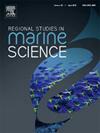In what ways do the toxic effects of chrysene and zinc affect one another? Answers from laboratory bioassays using meiofauna from Jeddah shores, Saudi Arabia
IF 2.1
4区 环境科学与生态学
Q3 ECOLOGY
引用次数: 0
Abstract
The study examined the effects of chrysene (i.e. 1 and 2 μg.g−1 Dry Weight (DW)) and zinc (i.e. 40 and 80 μg.g−1 DW), in single concentrations and mixtures, on meiobenthic amphipods in Saudi Arabia's Jeddah coastline. The results showed a decrease in the diversity of all benthic taxa after exposure to these substances. The study also found a significant decline in species diversity and abundance, particularly in the amphipods. Multivariate analyses revealed specific shifts in community structure, particularly in assemblages exposed to the highest concentrations of chrysene and zinc. This led to the establishment of a list of sensitive species for chrysene and zinc for future governmental policy purposes. The findings underscored the toxicity of chrysene and zinc in benthic amphipod communities, supported by computational modeling. Chrysene and zinc were detected in amphipod bodies with a clear proportionality with the magnitude of contamination.
甲苯和锌的毒性作用是如何相互影响的?使用来自沙特阿拉伯吉达海岸的珍稀动物进行实验室生物分析的答案
该研究检测了chrysene(即1和2 μg)的作用。g−1干重(DW))和锌(即40和80 μg)。g−1 DW),在沙特阿拉伯吉达海岸线的低底栖片脚类动物上的单一浓度和混合物。结果表明,暴露于这些物质后,所有底栖动物类群的多样性都有所减少。该研究还发现,物种多样性和丰度显著下降,尤其是片脚类动物。多变量分析揭示了群落结构的具体变化,特别是暴露于最高浓度的甲苯和锌的组合。这导致建立了一个敏感物种的名单,为未来的政府政策的目的。研究结果强调了在计算模型的支持下,底栖片足类动物群落中铬和锌的毒性。在片脚类动物体内检测到的铬和锌与污染程度成明确的比例关系。
本文章由计算机程序翻译,如有差异,请以英文原文为准。
求助全文
约1分钟内获得全文
求助全文
来源期刊

Regional Studies in Marine Science
Agricultural and Biological Sciences-Ecology, Evolution, Behavior and Systematics
CiteScore
3.90
自引率
4.80%
发文量
336
审稿时长
69 days
期刊介绍:
REGIONAL STUDIES IN MARINE SCIENCE will publish scientifically sound papers on regional aspects of maritime and marine resources in estuaries, coastal zones, continental shelf, the seas and oceans.
 求助内容:
求助内容: 应助结果提醒方式:
应助结果提醒方式:


